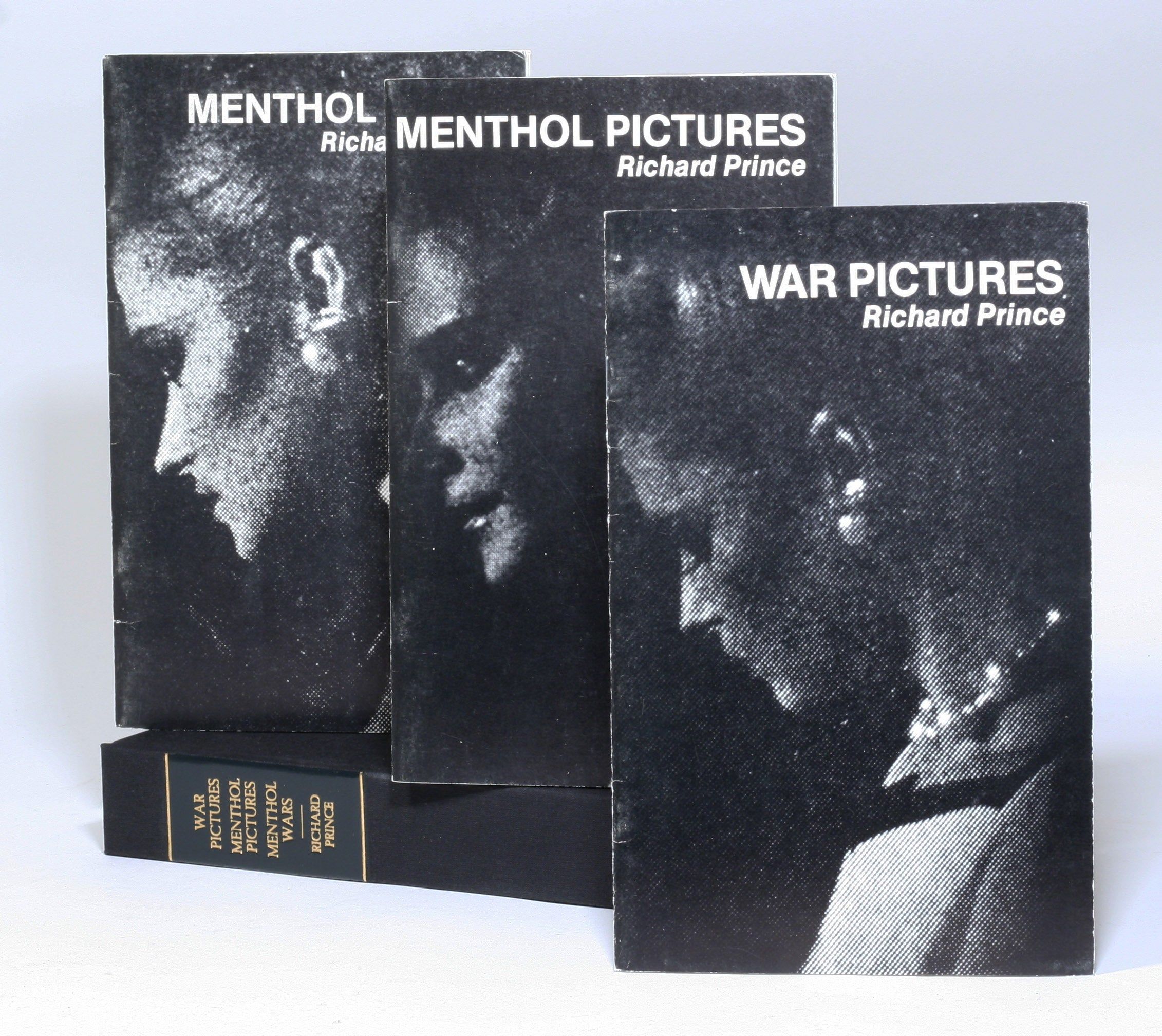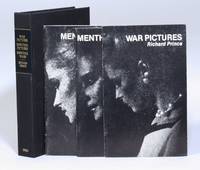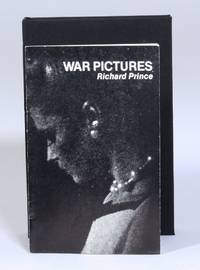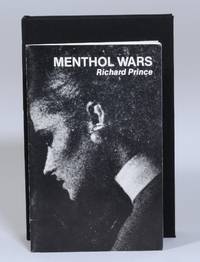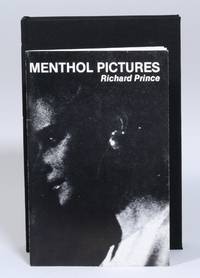War Pictures; Menthol Pictures; Menthol Wars
- SIGNED
- NY: Displayed at Artists Space, Cepa Gallery, Printed Matter, 1980
NY: Displayed at Artists Space, Cepa Gallery, Printed Matter, 1980. First. Very Good. RARE COMPLETE COLLECTION OF FIRST EDITIONS OF EARLY AND RARE RICHARD PRINCE NARRATIVE ARTWORK. Richard Prince is known for pushing the boundaries of art through his revolutionary re-photography technique—photographing existing commercial images and presenting them as his own. By removing images from their original context, Prince examined how media and consumer culture reflect and often share hidden cultural desires [Smith].
Prince’s early works are particularly rare— in a 1988 interview, Prince implied that he’d destroyed almost all of them, feeling he had grown out of these works as an artist. Still, Prince’s first artist-book series— War Pictures, Menthol Pictures, and Menthol Wars— marks a pivotal stage in his development, combining brief texts to create a type of Narrative Art. In these books, Prince explores narrative subjectivity, challenging the boundaries between individuals and consumer ideals, and introducing his early perspectives on media consumption [Pécoil], [Smith].
The New York Times Art Review commented on Prince’s early work:
“[Prince is] an artist who leaves few stones unturned as he progresses from generic to original to radical, carrying with him a fascination with language, photography and a range of printing and printmaking techniques, as well as the more banal forms of urban postwar Americana and a disconnected, decidedly male blankness. He conjures ancestor-gods like Johns, Warhol and Duchamp, and uses the monotype process meticulously and probably simply, if you could only figure out how” [Smith].
In War Pictures, Prince fragments narrative across multiple pages and uses blank space to both convey and disrupt the story. Menthol Pictures unfolds in three parts— War Picture, Horror Picture, and Sex Picture— while Menthol Wars, is the most extensive of the series, even including a table of contents and page numbers. War Pictures debuted at Artists Space in New York; Menthol Pictures appeared at Buffalo’s CEPA Gallery, where Prince met Director Larry Clark; and Menthol Wars was installed in a Printed Matter storefront window. Later, the original cover images from all three books were repurposed for a 1991 exhibition at Metro Photographs [Pécoil].
An excerpted section of each booklet is included below.
Menthol Pictures:
“Our collective unconscious holds all kinds of cliches, cliches so immediate, so obvious, that at times we respond to pedestrian situations as if they had existed before.
A lot of these collected cliches come from hours of late-night cinema viewing. We have seen thousands of hours of what is generally considered appropriate behavior in 'tight spots.' "
War Pictures:
"We are clients and agencies. We are performers and observers in a caterveld. We are not intellectual sloths asking noxious questions with an assumption. Our healthy conceit keeps us from physical waste and animal death. Our motive is to taste power and abdicate."
Menthol Wars:
"As I said before, Nancy likes James Bond movies because the punches are amplified before they even land. But her boyfriend, Frank, he likes the punches in 'Requiem For A Heavyweight,' because he says, you never actually see the punches thrown, Anthony Quinn just wears them on his face."
FIRST EDITIONS. Together, three volumes. New York and Buffalo, New York: Printed Matter, Artists Space and CEPA, 1980. Thin octavos, original photo-illustrated stiff wrappers; housed together in custom box. Only trivial wear to wrappers.
Essential works for understanding the artistic development of Richard Prince, Narrative Art, and the intimate relationship between media and the cultural unconscious. RARE.
References:
- Nos. 1, 2, 3 in "Bibliothèque d'un Amateur : Richard Prince's Publications" by Vincent Pécoil,
Yann Sérandour, Francine Delaigle, Christophe Daviet-Thery, Jérôme Saint-Loubert Bié.
Paris / Foligno, France / Italy : &: Christophe Daviet-Thery / VIAINDUSTRIAE Publishing,
2014, pp. 49, 50, 51, 131, 132, 133.
- Smith, Roberta. 2007. “Tracing a Radical’s Progress, Without Any Help From Him.” New York
Times, February 7, 2007.
- Richard Prince in Kristine McKenna, "On Photography: Looking for Truth Between the Lies," Los
Angeles Times, 19th May 1985, p. 91.
Prince’s early works are particularly rare— in a 1988 interview, Prince implied that he’d destroyed almost all of them, feeling he had grown out of these works as an artist. Still, Prince’s first artist-book series— War Pictures, Menthol Pictures, and Menthol Wars— marks a pivotal stage in his development, combining brief texts to create a type of Narrative Art. In these books, Prince explores narrative subjectivity, challenging the boundaries between individuals and consumer ideals, and introducing his early perspectives on media consumption [Pécoil], [Smith].
The New York Times Art Review commented on Prince’s early work:
“[Prince is] an artist who leaves few stones unturned as he progresses from generic to original to radical, carrying with him a fascination with language, photography and a range of printing and printmaking techniques, as well as the more banal forms of urban postwar Americana and a disconnected, decidedly male blankness. He conjures ancestor-gods like Johns, Warhol and Duchamp, and uses the monotype process meticulously and probably simply, if you could only figure out how” [Smith].
In War Pictures, Prince fragments narrative across multiple pages and uses blank space to both convey and disrupt the story. Menthol Pictures unfolds in three parts— War Picture, Horror Picture, and Sex Picture— while Menthol Wars, is the most extensive of the series, even including a table of contents and page numbers. War Pictures debuted at Artists Space in New York; Menthol Pictures appeared at Buffalo’s CEPA Gallery, where Prince met Director Larry Clark; and Menthol Wars was installed in a Printed Matter storefront window. Later, the original cover images from all three books were repurposed for a 1991 exhibition at Metro Photographs [Pécoil].
An excerpted section of each booklet is included below.
Menthol Pictures:
“Our collective unconscious holds all kinds of cliches, cliches so immediate, so obvious, that at times we respond to pedestrian situations as if they had existed before.
A lot of these collected cliches come from hours of late-night cinema viewing. We have seen thousands of hours of what is generally considered appropriate behavior in 'tight spots.' "
War Pictures:
"We are clients and agencies. We are performers and observers in a caterveld. We are not intellectual sloths asking noxious questions with an assumption. Our healthy conceit keeps us from physical waste and animal death. Our motive is to taste power and abdicate."
Menthol Wars:
"As I said before, Nancy likes James Bond movies because the punches are amplified before they even land. But her boyfriend, Frank, he likes the punches in 'Requiem For A Heavyweight,' because he says, you never actually see the punches thrown, Anthony Quinn just wears them on his face."
FIRST EDITIONS. Together, three volumes. New York and Buffalo, New York: Printed Matter, Artists Space and CEPA, 1980. Thin octavos, original photo-illustrated stiff wrappers; housed together in custom box. Only trivial wear to wrappers.
Essential works for understanding the artistic development of Richard Prince, Narrative Art, and the intimate relationship between media and the cultural unconscious. RARE.
References:
- Nos. 1, 2, 3 in "Bibliothèque d'un Amateur : Richard Prince's Publications" by Vincent Pécoil,
Yann Sérandour, Francine Delaigle, Christophe Daviet-Thery, Jérôme Saint-Loubert Bié.
Paris / Foligno, France / Italy : &: Christophe Daviet-Thery / VIAINDUSTRIAE Publishing,
2014, pp. 49, 50, 51, 131, 132, 133.
- Smith, Roberta. 2007. “Tracing a Radical’s Progress, Without Any Help From Him.” New York
Times, February 7, 2007.
- Richard Prince in Kristine McKenna, "On Photography: Looking for Truth Between the Lies," Los
Angeles Times, 19th May 1985, p. 91.


